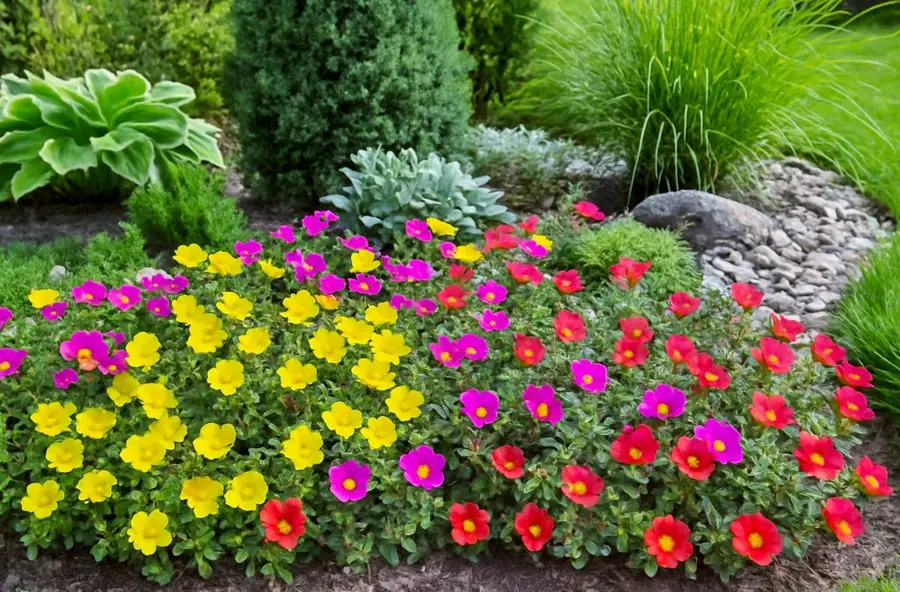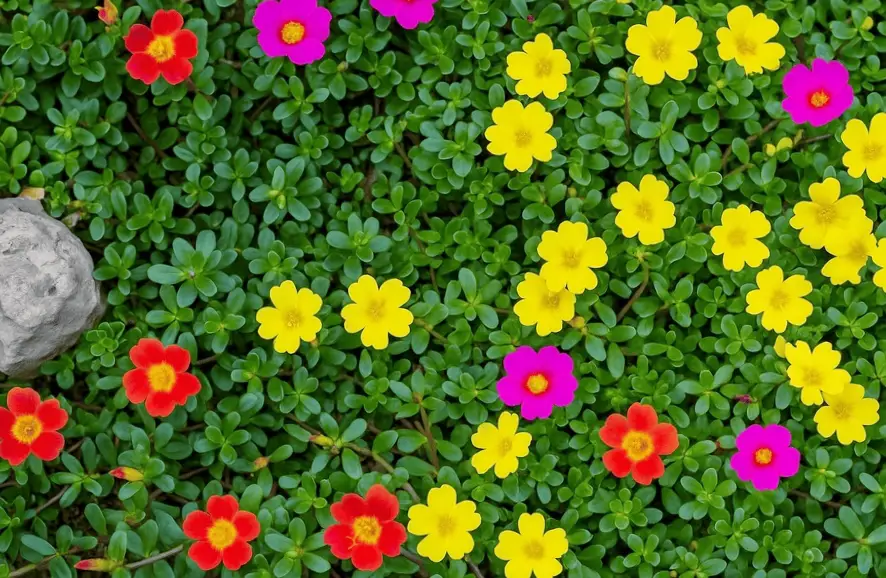
Moss Rose Ground Cover is the perfect fix when your garden needs a pop of color and your soil is dry and sunbaked.
Maybe you’ve tried other plants that either wither in the heat or struggle to thrive with minimal water.
Moss rose solves all that. It’s low-maintenance, tough, and blooms like crazy all summer long.
Moss Rose Ground Cover Key Takeaways
- Moss Rose Ground Cover is a low-growing, sun-loving annual known for its vibrant blooms and drought tolerance.
- Ideal for hot, dry spaces, it spreads easily and thrives with minimal care.
- Moss rose comes in a wide range of colors and is perfect for flower beds, containers, and rock gardens where other plants often struggle.
🌸 Moss Rose Ground Cover: Unstoppable Garden Charm, Perfect for Sunny Spaces
If you’ve got a sunny spot where nothing seems to grow, Moss Rose Ground Cover might just be your garden’s new best friend.
Tired of watching other plants wither in the heat? Moss rose thrives in tough conditions, spreading charm with vibrant, cheerful blooms that don’t quit, even in full sun and dry soil.
🌸 Introduction – A Power-Packed Bloom Carpet

Looking for a ground cover that pops with color and thrives in the heat?
Moss Rose Ground Cover (Portulaca grandiflora), also called Moss Rose Purslane, is a blooming machine that’s built for sunny, dry spots.
🌞 Why Gardeners Love Moss Rose
This cheerful little plant isn’t just pretty—it’s tough. Here’s what makes it stand out:
- 💧 Drought-tolerant: Handles dry spells like a champ
- 🌿 Low-growing and spreading: Fills in space fast without fuss
- 🌈 Blooms in bold colors: Think pink, yellow, orange, red, and more
- 🐝 Pollinator-friendly: Attracts bees and butterflies
- 🪴 Perfect for tough spots: Great for containers, rock gardens, and borders
🌼 What You’ll Discover in This Post
Whether you’re new to Portulaca moss rose or looking for fresh planting ideas, this guide will cover:
- How to grow moss rose successfully
- Care tips for nonstop blooms
- Design ideas and top varieties
- Common questions and answers
Let’s dig in and explore why moss rose ground cover deserves a sunny spot in your garden!
What Is Moss Rose? 🌼
Moss rose (Portulaca grandiflora) is a low-growing annual with a big personality.
It’s part of the Portulacaceae family and originally hails from the hot, dry plains of South America, making it perfect for sunny, drought-prone gardens.
🌿 Key Features of Moss Rose
- 🪴 Botanical name: Portulaca grandiflora
- 🌍 Native to: Argentina, Brazil, and Uruguay
- 🌱 Plant type: Warm-season annual
- 🌸 Flower style: Single, semi-double, or fully double blooms
🌈 A Rainbow of Blooms
Moss rose flowers come in nearly every warm shade you can imagine:
- Pink, yellow, orange, red, white, peach, lavender, and magenta
- Many modern varieties include bicolors, stripes, and pom-pom-style blooms
- Flowers typically open in bright sun and close at night (though some hybrids stay open longer)
🌵 Succulent and Spreading
Moss rose has a semi-succulent growth habit:
- 🌿 Fleshy leaves and stems that store water
- 🌿 Prostrate and trailing stems create a carpet effect
- 🌿 Grows up to 3–8 inches tall and 12 inches wide
- 🌱 Fast-growing and easy to propagate
This cheerful plant may be small, but it’s packed with garden potential.
Moss rose, Portulaca grandiflora, is a drought and heat tolerant annual native to hot, dry plains in Argentina, southern Brazil, and Uruguay. This herbaceous plant in the purslane family (Portulacaceae) is cultivated throughout the world as a garden annual for its showy flowers that bloom all summer long with little care. https://hort.extension.wisc.edu/articles/moss-rose-portulaca-grandiflora/
🌞 Why Choose Moss Rose as a Ground Cover?
When it comes to covering bare soil with beauty, Moss Rose Ground Cover checks all the boxes.
It’s not just a pretty face, it’s a workhorse in hot, dry conditions where other plants give up.
💪 Built for the Heat
Moss rose thrives where many plants struggle:
- ☀️ Loves full sun—the brighter, the better
- 🔥 Heat and drought-tolerant—perfect for summer survival
- 🏜️ Great for sandy, rocky, or lean soil—doesn’t need rich dirt to perform
🌸 Colorful and Compact
Want flowers that don’t quit?
- 🌈 Blooms nonstop all summer
- 📏 Short and spreading habit makes it a great ground cover
- 🌿 Dense mat of foliage helps reduce weeds
🪴 Easy to Work With
This plant is a true low-maintenance pick:
- 🐝 Attracts pollinators like bees and butterflies
- 💧 Minimal watering once established
- ✂️ Deadheading optional but can encourage even more blooms
- 🌱 Self-seeds lightly or can be planted from seed or cuttings
If you’re after a vibrant, fuss-free plant that handles heat with style, Portulaca moss rose is your garden’s secret weapon.
🌱 How to Grow Moss Rose
Moss Rose Ground Cover is easy to grow—even if you’re not exactly a green thumb. As long as it gets plenty of sun and well-drained soil, this plant practically grows itself.
🌎 Planting Zones
- 📍 USDA Zones: 2–12 (grown as an annual)
- ❄️ Not frost-hardy—plant after your last spring frost
☀️ Sunlight Requirements
- Needs 6–8 hours of direct sunlight daily
- The more sun, the more blooms!
🌱 Soil Preferences
- Loves sandy, gravelly, or rocky soil
- Must be well-draining—it hates wet feet!
💧 Watering Needs
- Water sparingly
- Let the soil dry out between waterings
- Overwatering = root rot risk
🌿 Fertilization Tips
- 💡 Skip the fertilizer for best blooms
- If you must, use a diluted, low-nitrogen mix
- Too much fertilizer = fewer flowers
🌸 Propagation
- Super simple to grow from seed or cuttings
- 🌾 Seeds: Sow directly after frost or start indoors 4–8 weeks early
- ✂️ Cuttings: Root easily in moist soil or water
With just a little effort upfront, Portulaca moss rose will reward you with nonstop summer color and zero stress.
Moss Rose Plant Care Reference Guide
| Characteristic | Details |
|---|---|
| Common Name | Moss Rose |
| Botanical Name | Portulaca grandiflora |
| Native Habitat | South America (Argentina, Brazil, Uruguay) |
| Plant Type | Annual, Succulent Ground Cover |
| Growth Pattern | Low-growing, spreading, mat-forming |
| Mature Size | 3–8 inches tall, 12–18 inches wide |
| Watering | Low; drought-tolerant once established |
| Light/Sun Exposure | Full sun (6–8 hours daily) |
| Soil Type | Sandy, well-draining soil |
| Soil pH | 6.0–7.0 (slightly acidic to neutral) |
| Temperature | Prefers warm weather; frost-sensitive |
| Humidity | Tolerates low humidity |
| Bloom Time & Flower Color | Summer to fall; pink, red, yellow, orange, white, lavender, bicolors |
| Potential Problems | Root rot in wet soil; occasional aphids or slugs |
| Repotting | Not typically needed unless used in containers |
| Hardiness Zones (USDA) | Zones 2–11 as annual |
🎨 Design Ideas for Using Moss Rose
Moss Rose Ground Cover isn’t just tough, it’s downright gorgeous.
With its bright blooms and trailing habit, this plant fits into almost any sunny garden setup.
🪻 Garden Beds & Borders
- Use moss rose to fill in gaps between taller plants
- Great along walkways, driveways, or garden edging
- Adds a splash of color where other plants can’t keep up
🪨 Rock Gardens & Dry Landscapes
- Thrives in sandy, rocky spots where most flowers fail
- Looks stunning tucked between boulders or along dry slopes
- Perfect for xeriscaping or desert-style landscapes
🪴 Containers & Hanging Baskets
- Gorgeous in pots and planters—spills over the edges
- Mix with nasturtiums, zinnias, or sweet potato vine
- Try them solo in a low bowl for a full, mounding look
🧑🌾 Companion Planting
- Pairs beautifully with:
- 🌼 Zinnias – height and bold colors
- 🌿 Nasturtiums – similar growing needs and fun textures
- 🍠 Ornamental sweet potato vine – contrasting foliage (watch the vine—it grows fast!)
Whether you’re working with a balcony planter or a full flower bed, Portulaca moss rose is a fun and flexible plant that brings charm to any sunny space.
Popular Moss Rose Varieties 🌺
One of the best things about Moss Rose Ground Cover is the huge variety of colors and flower forms.
From pom-pom doubles to bold bicolors, there’s a Portulaca out there to match every garden vibe.
🌈 Top Varieties to Grow
Here are some standout options to try:
- 🌞 ‘Afternoon Delight’
- Large 2-inch flowers
- Stays open longer into the afternoon
- 🌸 ‘Calypso Mix’
- Bright double blooms
- Comes in red, pink, orange, yellow, purple, and white
- 🎨 ‘Duet’
- Unique bicolor single flowers
- Compact and free-flowering
- 🧚 ‘Fairy Tale’ Series
- Double pom-pom centers with flat outer petals
- Includes fun names like ‘Cinderella’, ‘Snow White’, and ‘Sleeping Beauty’
- 🌴 ‘Happy Hour’ Series
- Early blooming, less sensitive to day length
- Colors include ‘Banana’, ‘Rosita’, ‘Lemon’, and ‘Coconut’
- 🌵 ‘Margarita’ Series
- Compact, mounding, early-blooming plants
- Available in classic red, orange, yellow, white, pink, and purple
- 🌞 ‘Sundial’ Series
- Double blooms that open even on cooler, cloudy days
- Includes shades like ‘Fuchsia’, ‘Peach’, and striped ‘Peppermint’
- 🌅 ‘Tequila’ & ‘Happy Trails’ Series
- Hybrids with improved cool-weather tolerance
- ‘Happy Trails’ replaced ‘Tequila’ with a fuller range of colors
- 🌼 ‘Yubi Summer Joy’
- Big, nearly 3-inch single flowers
- Trailing habit with bold leaves and extended bloom time
With so many choices, you can mix and match varieties to create a living rainbow in your garden beds, rock walls, or containers.
Common FAQs About Moss Rose ❓🌸
Got questions about Moss Rose Ground Cover? You’re not alone!
Here are the most common things people ask, answered in plain, friendly language so you can grow with confidence.
🪴 Is moss rose a good ground cover?
Yes! It spreads easily, stays low, and blooms nonstop in sunny spots—making it a top choice for dry, tough areas where other plants fail.
🌼 Does moss rose come back every year?
Moss rose is an annual, but it can reseed itself in warm zones. You may see new plants pop up next season if the seeds land in just the right spot.
🌱 Is moss rose invasive?
Nope. It spreads nicely in your garden beds, but it’s easy to manage and won’t take over your yard like true invasives do.
☀️ Does moss rose like sun or shade?
Full sun is a must. Less light means fewer blooms. Give it at least 6–8 hours of sunlight daily for the best show.
✂️ Should moss roses be cut back?
You don’t have to, but a little midseason trim can tidy things up and encourage more blooms. Pinching off faded flowers (deadheading) also helps.
🐶 Are moss roses toxic to dogs?
Yes, they are mildly toxic if eaten, so keep them out of reach of curious pets and kiddos.
🐛 Does moss rose attract bugs?
They’re mostly pest-free, but you might occasionally see aphids or slugs. Nothing major, and pretty easy to manage.
🌿 What are the benefits of moss rose?
- Low-maintenance
- Drought-tolerant
- Fast-spreading
- Blooms all summer
- Great for tough, sunny areas
❄️ How do you take care of moss roses in the winter?
Since they’re not frost-hardy, they won’t survive cold weather. But you can collect seeds or take cuttings before frost if you want to grow them again next year.
Final Thoughts: Bring on the Bloom with Moss Rose 🌞🌸
Moss Rose Ground Cover is proof that a tough plant can still be a showstopper.
It gives you bold color, spreads like a cheerful little mat, and keeps blooming even when the sun’s blazing and water is scarce.
Whether you’re planting between rocks, in containers, or along sunny borders, this easy-going beauty always shows up with charm.
✅ Why You’ll Love Moss Rose:
- 💧 Handles drought like a pro
- 🌈 Bursts with vibrant, nonstop color
- 🌿 Spreads easily without getting out of control
- 🪴 Fits in beds, baskets, borders, and beyond
So if your garden needs a little heat-proof magic, give Portulaca moss rose a try—you’ll wonder how you ever gardened without it.
Xeriscape Ground Covers: Best Smart Choices for Dry Zones
References
What is Xeriscaping? (Including Best Plants for Your Zone) – Nevada NID
Designing Landscapes for Northern Nevada’s Arid Climate – Nevada Extension
South Texas Wildscape and Xeriscape-plants/ Texas A&M Extension
New Mexico Xeric Guide – NM.Gov
Low Water Use/Drought Tolerant Plant List – Arizona Department of Water Resources
The Beginners Guide to Xeriscape in Denver – 5280 Magazine Denver’s Mile High Magazine
What is xeriscaping? A beginner’s guide to drought-tolerant landscaping – Colorado State University
What is xeriscaping? A beginner’s guide to drought-tolerant landscaping – Colorado State University
UCCE Master Gardeners of San Joaquin County – Low Water Use Landscapes
